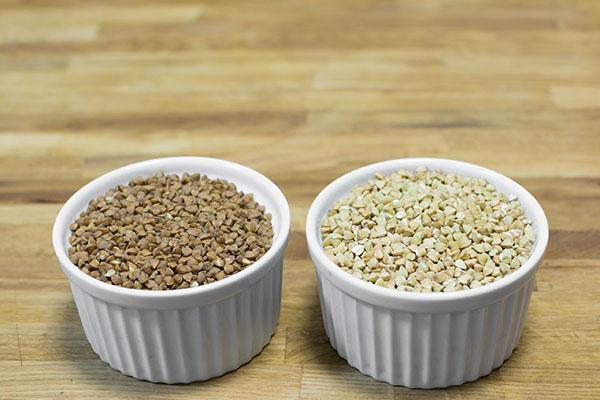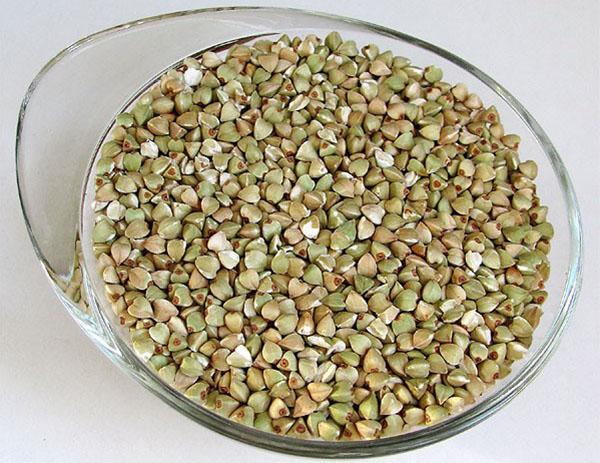The benefits and harms of green buckwheat for our health
 Buckwheat porridge is a favorite dish of many Russians. But the benefits and harms of green buckwheat are controversial among modern nutritionists. Many of them agree on only one thing - brown, roasted grains are less useful than green ones.
Buckwheat porridge is a favorite dish of many Russians. But the benefits and harms of green buckwheat are controversial among modern nutritionists. Many of them agree on only one thing - brown, roasted grains are less useful than green ones.
Where did buckwheat come from in Russia

Content of nutrients
In green buckwheat, the protein content reaches 18%, fats - 4%, carbohydrates up to 23% of the daily value. If we consider the percentages obtained in grams, then 100 g of protein will be 13.3 g, fats 3.4 g, carbohydrates 71.5 g. Most of all in the green buckwheat vitamins B9 and B3.
There are no fat-soluble vitamins in this cereal, only water-soluble vitamins, such as:
- B1 - thiamine, promotes better metabolism (0.1 mg);
- B2 - riboflavin, necessary for skin, nails, hair, growth regulation and the body's ability to reproductive functions (0.4 mg);
- B3 - its forms are nicotinic acid (vitamin PP) and niacin (7.0 mg);
- B5 - pantothenic acid, an important component of fat metabolism, carbohydrate, necessary for the synthesis of hemoglobin (1.5 mg);
- B6 - pyridoxine, is involved in metabolic processes, is important for normal liver function (0.2 mg);
- B9 - folic acid, essential for the normal development of the circulatory and immune systems (30 mcg).
The calorie content of green buckwheat is 310 kcal per 100 g of raw product, boiled - 110 kcal.
As part of 100 g of this cereal, which is important for the human body, there is magnesium (231.0 mg), the volume of which is 50% of the total daily requirement. The copper content is 64%, far exceeding the required amount of this essential trace element. Phosphorus (347.0 mg) - a trace element involved in all biological processes, ensuring the normal growth of dental and bone tissue, makes up 37% of the required amount. The chemical composition of green buckwheat contains a lot of potassium (460.0 mg), a kind of water balance regulator, a trace element that normalizes the heart rate. Its volume is only 15.2% of the required. The product also contains manganese, selenium, sodium, zinc, calcium and iron, without which the normal functioning of the human body is impossible.
The benefits and harms of green buckwheat
 Ordinary buckwheat, which is not fried before storage and sending to the retail network, has a greenish color. And the more familiar to consumers, brown, with a pronounced odor, is a pre-processed product. They have different properties. But if these products, during the preparation process, are boiled, in their value, they will become almost identical. This is due to the fact that under the influence of heat treatment, most vitamins and rare microelements will simply collapse. Therefore, boiling green buckwheat and fried, brown, will not lead to a noticeable difference in their composition.
Ordinary buckwheat, which is not fried before storage and sending to the retail network, has a greenish color. And the more familiar to consumers, brown, with a pronounced odor, is a pre-processed product. They have different properties. But if these products, during the preparation process, are boiled, in their value, they will become almost identical. This is due to the fact that under the influence of heat treatment, most vitamins and rare microelements will simply collapse. Therefore, boiling green buckwheat and fried, brown, will not lead to a noticeable difference in their composition.
Buckwheat is especially useful for those people who are trying to lose weight.Fiber, which is found in green buckwheat, has a positive effect on the intestinal microflora.
Therefore, it is part of many diets and, often, forms their basis. In addition, it contains a large amount of trace elements and vitamins, which allows the body to effectively shed pounds and not suffer from a lack of nutrients.
One of the valuable properties of green grains is that their glycemic index is only 50 units, for brown buckwheat - 60 units, which makes it possible to use both of these types for people suffering from diabetes. Green buckwheat shows its valuable properties most fully in the germinated form. It also improves the condition of the cardiovascular system, reduces the possibility of developing a heart attack. Due to the lack of gluten (gluten), buckwheat is suitable for people suffering from its intolerance.
How to germinate grains of green buckwheat
 Sprouted buckwheat has the most valuable properties. It has a high energy value, strengthens the immune system and cleanses the body. This is why green sprouted buckwheat is useful.
Sprouted buckwheat has the most valuable properties. It has a high energy value, strengthens the immune system and cleanses the body. This is why green sprouted buckwheat is useful.
To get a product that allows you to give the human body the maximum possible amount of minerals, vitamins, organic amino acids that it contains, you should prepare it as follows:
- Fill green grains with water and remove all floating elements.
- Pour into a colander, rinse under running water.
- Transfer the clean grains to a wide-bottomed dish, preferably glass.
- Pour with purified, but not boiled water, based on the proportion - for one part of buckwheat, three parts of water.
- After two to three hours, the swollen grains must be washed again, spread on the dishes in a thin layer. Cover with gauze.
- Close the dish with a lid loosely so that the cereal "breathes" and put it in a warm place for a day.
- During the day, buckwheat should be washed every 10 hours, very carefully so as not to damage the sprouts.
- After a day of germination, the average length of the emerging shoots should be from 2 mm to 3 mm. These sprouts are best eaten. To prevent them from overgrowing, they should be refrigerated.
It is believed that after the germination of green buckwheat grains begins, they become maximally useful only after two days.
Do not leave sprouts at the time of germination for more than 10 hours without rinsing. An irreversible fermentation process will begin, due to which the grains will become unusable.
How to use green buckwheat and sprouts
 The human body easily assimilates green buckwheat. Its tenderness and pleasant taste make it possible to prepare various dishes from this cereal. Very healthy buckwheat flour can be easily made at home. To do this, you just need to rinse the beans, dry them and grind them on a coffee grinder. The resulting flour can be added to wheat flour when baking pancakes, pancakes and other dough products.
The human body easily assimilates green buckwheat. Its tenderness and pleasant taste make it possible to prepare various dishes from this cereal. Very healthy buckwheat flour can be easily made at home. To do this, you just need to rinse the beans, dry them and grind them on a coffee grinder. The resulting flour can be added to wheat flour when baking pancakes, pancakes and other dough products.
Before using green buckwheat and preparing dishes from it, you need to sort it out - remove non-standard grains, and then rinse. In order to preserve the beneficial properties of this cereal, valuable for the body, it should be soaked overnight, then rinsed and used. But, if time is limited, you can soak buckwheat for two hours or even 30 minutes. This cereal is steamed in a thermos, added to stewed vegetables, or eaten with chopped nuts... Green buckwheat sprouts are added to various dishes, as well as dried and used as an effective prophylactic agent.
 What else is green buckwheat useful for? Thanks to the antioxidant proanthocyanidin contained in this cereal, you can slow down the development of pathological processes. This product is a good prevention of cancer. It is necessary for those who are experiencing great physical and mental stress. The health benefits of green buckwheat can hardly be overestimated.The systematic consumption of foods made from green grains and their sprouts will help keep the body healthy for many decades, slow down the aging process and allow a person to be more mobile and energetic.
What else is green buckwheat useful for? Thanks to the antioxidant proanthocyanidin contained in this cereal, you can slow down the development of pathological processes. This product is a good prevention of cancer. It is necessary for those who are experiencing great physical and mental stress. The health benefits of green buckwheat can hardly be overestimated.The systematic consumption of foods made from green grains and their sprouts will help keep the body healthy for many decades, slow down the aging process and allow a person to be more mobile and energetic.